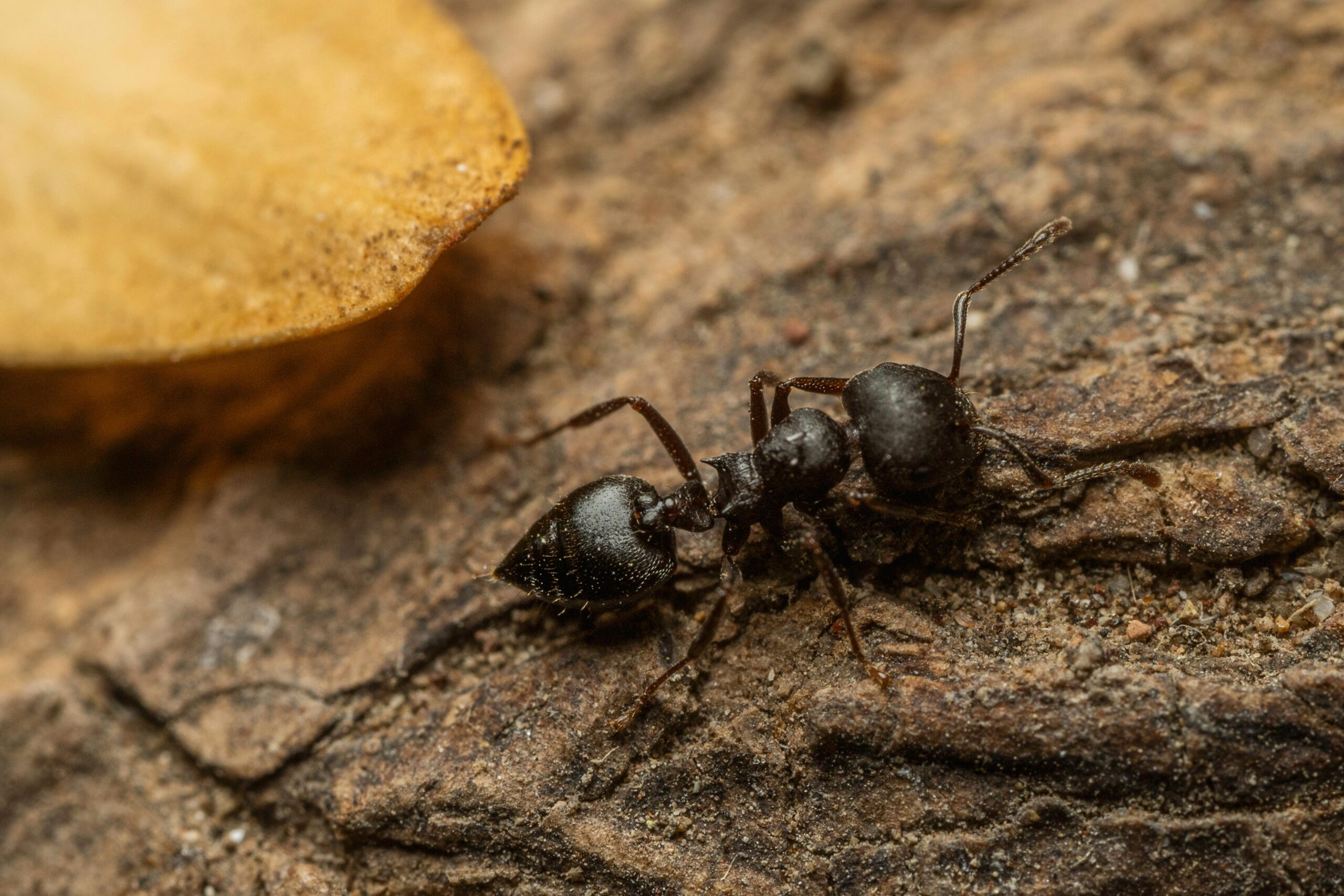Springtime is a welcome reprise from Iowa’s winter chill, but for many property owners, it also marks the start of an annual battle with a surprisingly common pest—ants!
These tiny invaders seem to appear out of nowhere, marching across countertops, into pantries, and across floors. But why is spring the prime time for ant activity in Iowan cities, such as Des Moines, Urbandale, and Altoona?
Understanding the behavior of ants and the seasonal factors that trigger their movements can help you prepare and prevent infestations before they take over your home. Janssen Pest Solutions is here to explain why ants are so active in the spring and teach you how you can handle them.
Key Takeaways
- Spring Awakening: As temperatures rise in spring, ants such as odorous house ants, carpenter ants, pavement ants, and field ants become more active, leaving their colonies in search of food, water, and shelter.
- Common Entry Points: Ants often enter homes through small cracks in walls, windows, doors, and foundations, looking for easy access to food and moisture.
- Species Identification: Iowa homes are commonly invaded by sugar ants, carpenter ants, and other species like pavement and field ants, each with unique nesting preferences and behaviors.
- Nuisance and Damage: While some ants are simply a nuisance, others, like carpenter ants, can cause structural damage by tunneling into wood. Identifying the type of ant is essential for proper treatment.
- Prevention is Key: Sealing entry points, removing food sources, and maintaining a dry home environment are essential strategies to keep ants out. Professional pest control may be necessary for large or persistent infestations.

1. Seasonal Behavior of Ants
Ants are cold-blooded insects, which means they are heavily influenced by temperature. During the cold winter months, most ants hunker down in their colonies, entering a semi-dormant state. Their activity slows significantly as they wait for warmer weather.
As the weather warms up in early spring, ant colonies “wake up,” and workers begin foraging for food, water, and mates. This burst of activity is a sign that ants are once again looking for places to establish their nests and sustain their colonies. The increase in spring temperatures signals that it’s time to replenish food sources and expand their reach.
Just as humans feel the call of spring to open windows and breathe in fresh air, ants are motivated to explore. They will search for easy entry points into homes, leading to a noticeable uptick in indoor activity. That’s why many homeowners turn to Des Moines pest control services in the spring to safeguard their properties from ant invasions and keep these persistent pests at bay.
2. Iowa’s Climate and Ant Activity
Iowa’s unique climate plays a crucial role in ant behavior. The state experiences long, harsh winters followed by rapid spring thaws. As the snow melts and temperatures rise, ants emerge in search of food and moisture. Foragers first start looking for food sources outside, but as the ground thaws and food becomes scarcer in the natural environment, ants will move inside, seeking shelter and sustenance.
The combination of Iowa’s chilly winters and relatively mild spring temperatures provides an ideal environment for ants to thrive. The transition from extreme cold to warmer temperatures is a trigger for ants, urging them to venture out of their underground nests in search of food and water.
3. Common Types of Ants Found in Iowa During Spring
Not all ants are the same. In Iowa, several species of ants are particularly active during the spring, each with its own reasons for seeking out your home:
- Sugar Ants: Also known as odorous house ants, sugar ants are attracted to sweets and greasy foods. They are commonly found in kitchens, where they form visible trails between food sources and their nests.
- Carpenter Ants: These larger ants are notorious for damaging wood structures. They do not eat the wood, but they create nests by tunneling through it. Carpenter ants are particularly attracted to areas of the home with moisture, making damp basements and attics prime targets.
- Pavement Ants: These ants tend to nest under cracks in sidewalks and driveways. They are often found foraging around homes in the spring, looking for food, especially in places like gardens or patios.
- Field Ants: Typically found outdoors, field ants may enter homes seeking warmth during chilly nights. Though not as commonly seen indoors, they are attracted to sugary foods and can be a nuisance if their nests are disturbed.
Each of these species has different needs and preferences, but all share one thing in common: a drive to establish colonies and expand their search for food when the weather warms up.
4. Why Ants Enter Your Home in Spring
So, why do ants invade your home, specifically during spring? There are a few key reasons:
- Food and Water Sources: Ants are constantly in search of food and water to support their colonies. The abundance of food in homes during spring, from leftover crumbs to sugary snacks, attracts ants looking to nourish their colony. Kitchens, pantries, and dining areas are prime targets for foraging ants.
- Nesting Locations: As ants increase their activity in spring, they also look for new nesting sites. Homes offer shelter from predators and adverse weather conditions. Cracks in foundations, gaps in windows, and holes around doors provide perfect entry points for ants seeking to establish a nest inside.
- Warmth: During the cool nights of early spring, ants may seek the warmth of your home to maintain their colony’s survival, especially if outdoor conditions become too chilly for comfort.
5. Signs of Ant Infestation in Spring
How do you know if ants have infiltrated your home? Look for these common signs of an infestation:
- Ant Trails: One of the most obvious signs of ants is the appearance of trails leading to and from food sources or entry points. Ants use pheromones to communicate with each other, leaving scent trails that other ants follow to food.
- Visible Nests: If you notice small piles of dirt or mud near cracks in walls or along your foundation, you may be dealing with ants that are building nests in your home or garden.
- Increased Activity Around Food: If ants are constantly found around food sources or containers, it’s a clear sign that they’ve established a foraging trail within your home. Their consistent presence around food is an indication that they’ve located a stable food source.
6. How to Prevent Ants in Your Home During Spring
Prevention is key when it comes to managing ants in your home. Here are some practical steps you can take to keep these pests at bay:
- Seal Entry Points: Make sure to check and seal any cracks in walls, around windows, doors, and around the foundation of your home. Ants are very small and can squeeze through the tiniest of gaps.
- Proper Waste Management: Store food in airtight containers and make sure to clean up crumbs and spills promptly. Keeping trash cans tightly sealed will also reduce the chances of attracting ants into your home.
- Eliminate Moisture Sources: Fix leaky faucets, pipes, or appliances, especially in kitchens and bathrooms, where ants seek out moisture. Ants like carpenter ants are particularly drawn to moist, decaying wood.
- Professional Pest Control: If you notice persistent or large-scale infestations, it’s best to consult with a professional pest control service. Experts have the tools and knowledge to effectively identify ant species and implement treatment strategies.
Conclusion
Ants may be tiny, but they can cause huge problems for homeowners in Iowa during the spring. Their seasonal behavior, combined with the state’s climate, makes spring the perfect time for ants to invade.
By understanding why ants are so active during this time and how they enter your home, you can take proactive measures to prevent infestations and protect your home from these common springtime pests. Keep an eye out for signs of activity, and don’t hesitate to contact a Des Moines pest control professional, like Janssen Pest Solutions, if the problem becomes overwhelming.
If you’re dealing with ants in your home this spring, don’t wait until the infestation gets out of hand. Contact us for a comprehensive inspection and effective solution to keep ants at bay this season.
FAQ: Common Questions About Ants in Iowa
1. Why do I only see ants in the spring?
Ants are more active in spring because warmer temperatures trigger their foraging behavior after the winter dormancy. As they leave their colonies to search for food and water, they may invade homes looking for sustenance or a suitable nesting site.
2. How can I prevent ants from coming into my home?
The best way to prevent ants is by sealing cracks and gaps around windows, doors, and foundations. Additionally, keep food in airtight containers, clean up crumbs and spills immediately, and reduce moisture sources by fixing leaks in plumbing or appliances.
3. What are the signs of a carpenter ant infestation?
Carpenter ants are larger than other ants and may leave behind small piles of sawdust-like debris near nesting sites. They tend to nest in moist, decaying wood, so areas like attics, basements, and around windows or doors that may have water damage are common hotspots.
4. Are odorous house ants dangerous?
While odorous house ants are not harmful to humans, they can be a significant nuisance. They are attracted to food and moisture, and although they don’t cause physical damage, their presence in the kitchen or pantry can be frustrating.
5. How do I know if I have an ant infestation or just a few ants?
If you notice consistent ant trails or an increase in ants around food sources, there may be an infestation. Small numbers of ants that appear intermittently might just be occasional foragers, but consistent activity, especially inside the home, is a sign that they’ve established a trail or a nest.

